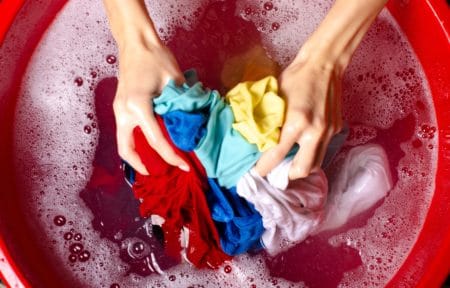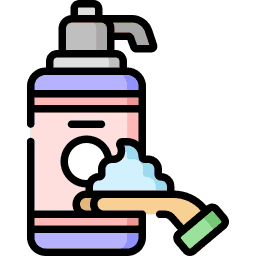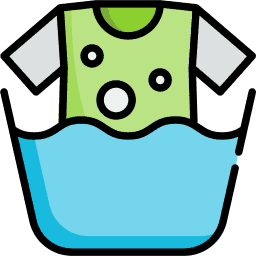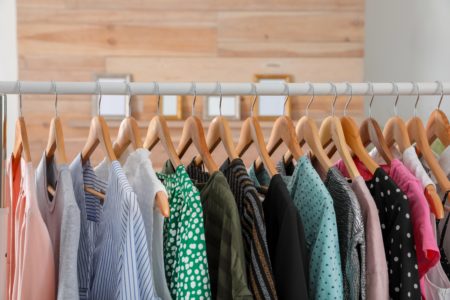Hand washing clothes is not a thing of the past. This seemingly archaic laundry hack will actually help you care for your clothes. It comes in especially handy for delicates, wools, and silk items.
We’ll teach you how to hand wash clothes so that you take good care of your favorite pieces. Keep reading to find out exactly how to hand wash bras, shirts, underwear and more.
Key Takeaways
- Hand washing clothes is ideal for delicate items like silk, wool, and cashmere.
- Use a tub or basin, mild detergent, and cool or lukewarm water for hand washing.
- Gently swish the clothing item in water, rinse, and press against the tub to remove excess water.
- Dry the clothes on a mesh rack or towel and avoid using a tumble dryer.
Is It Better to Hand Wash Clothes?
A lot of washing machines have a hand wash or delicate cycle option. But sometimes, it’s better to do it by hand. You have more control over what happens to the garment. For items such as silk, wool, cashmere, and delicate items, handwashing allows you to wash them as gently as you’d like.
Always check the label of your garment. It will state whether it’s hand wash only. If so, it’s always better to wash that item by hand.
On the other hand, handwashing takes a lot of time. It also requires extra work to remove stains. So if you have other options, you might want to weigh up the pros and cons.
What You Need
If you are going to go down the well-loved route of handwashing, follow these instructions. First, gather your supplies. You will need:
- A hand washing detergent. (Alcohol-free).
- Tub or basin.
- White lint-free towels.
- Drying rack.
- Gloves (optional).
Protect Yourself
How to Hand Wash Clothes
We’ll take you through different materials and share our tips on how to hand wash by fabric type. This will ensure the best care for individual garments.
Bras
- Prepare your basin: Fill your tub or basin with lukewarm water. Add a teaspoon of your alcohol-free detergent. Mix well.
- Soak the bra: Let the bra soak in soapy water for 15 minutes.
- Clean: With your hands, work the soap into your bra. Gently rub the fabric to help loosen and remove dirt.
- Rinse the bra: Take the bra out of the water and hold it under the faucet. Let the water run over the fabric until all the soap residue is gone.
- Dry the bra: Use your lint-free towel and fold the bra against it to remove excess water. Lay it flat between the two towels and press down to remove even more water. Now, hang the bra to dry.
Underwear
- Prepare your basin. Fill your tub or basin with cool water. Add a small squirt of your alcohol-free detergent. Mix well.
- Submerge the underwear: Fully submerge the underwear into the water.
- Swish: Swish the undies around to loosen dirt and stains. You can scrub them gently, too. Then let them soak for a few minutes.
- Rinse, if necessary: Check your laundry detergent, as some hand wash formulas don’t require an extra rinse.
- Dry: Remove the underwear from the water. Pat them dry with a towel. Then roll them up into a towel to remove excess water. Hang to dry or lay flat on a dry towel.
Shirt
- Check the label: Check the label on the shirt to see what temperature is best.
- Prepare your basin: Fill the basin with water at the temperature corresponding to the recommendation on the care label. Add the correct amount of mild detergent, depending on how big your tub or basin is. Mix until dissolved.
- Add clothes: Add clothes to the basin, one at a time.
- Soak: If the clothes are stained, soak them for 30 minutes.
- Wash: Now, rub the fabric gently against itself to clean dirt from the shirt.
- Fill another tub: This is optional, but if you want to add fabric softener, fill another tub and add a small amount of fabric softener.
- Soak the shirt: Soak the shirt in the fabric softener solution for about 20 minutes.
- Empty your basin: Empty the original basin and refill it with clean water.
- Rinse: Rinse the shirt to get rid of detergent residue.
- Dry: Roll in a towel to remove excess water, then hang to dry.
Sweater
- Prepare your basin: Fill your tub or basin with lukewarm water. Add a few drops of detergent.
- Soak the sweater: Turn the sweater inside out to protect the outer fabric. Immerse it fully in the water and gently swish it around. Make sure not to stretch it. Leave to soak for 10 minutes.
- Rinse: Gently let cold water run over the sweater, removing detergent residue.
- Dry: Press the sweater gently against the side of your tub or basin. This will remove water. Lie it down on a white towel, since white towels won’t stain your sweater. Roll the towel and sweater together, like a burrito, to remove excess water.
- Lay flat: Now, lay the sweater flat on a mesh drying rack. This lets moisture circulate. Keep it out of the sun and away from heat. Keep the sweater as close to its original shape as possible so it dries well.
Jeans
- Prepare your basin: Fill your tub or basin with lukewarm water. Add a few drops of your detergent. Mix well.
- Add jeans: You can turn your jeans inside out if you’d like. Submerge your jeans fully under the water.
- Wash: Use your hands to wash your jeans, shaking them around under the water. Let them soak for 30 minutes.
- Remove jeans: Remove the jeans and drain the tub or basin.
- Refill: Put the jeans back in the tub or basin, and refill with cold water.
- Soak: Submerge the jeans under the water and let them soak for five or ten minutes.
- Drain the water: Drain the water and drip the jeans out.
- Hang the jeans: Put them on a clothes hanger and place them somewhere they can drip dry. You could try your shower head! You might want to turn on your heating to speed this process up.
Wool
- Prepare your basin: Fill a tub or basin with cold water. Add a teaspoon of detergent and mix it around.
- Soak the item: Add the wool item to the water and swish the item around for about 30 seconds. Be gentle. Leave for 15 minutes.
- Drain the water: Let the water drain.
- Rinse: Gently rinse the item under the tap to get out any excess water.
- Hang to dry: Hang the wool items to dry over a drying rack or on top of a towel.
Silk
- Prepare your basin: Fill a tub or basin with cold water. Add a teaspoon of your mild detergent. Mix well.
- Clean: Agitate the silk item gently for about five minutes. You can do this by rubbing the fabric softly together, swirling it around in the water or rubbing it with your hands.
- Rinse: Empty the basin or tub and refill with cold water. Rinse it until all the soap suds are gone.
- Squeeze excess water out: Gently press the silk item against the side of your tub or basin to drain excess water. Don’t ever twist or wring silk items. It can damage the fabric.
- Place on a towel: Lay down a white lint-free towel and place the silk item flat on top. Roll it up to get rid of the water. Unroll and repeat with a dry towel.
- Hang to dry: Lie the silk item flat on a drying rack or another dry towel. Let it dry completely.
How to Dry Hand Washed Clothes
In general, there are three useful steps to drying your hand-washed clothes. None of them involve a dryer! If an item needs handwashing, then it definitely can’t handle a tumble dryer. The force of the dryer can stretch out delicates or even shrink fabrics.
- Squeeze out the water: You want to get out as much water as possible to speed up the drying time. Don’t twist or wring the items. Gently squeeze the water out by hand or by pressing against the side of your basin.
- Lay on a towel: Lie your clean towel on a flat surface before placing the clean garment on top. Make sure to keep everything smooth and flat to avoid wrinkles and reshaping. Roll up the towel and gently press to remove excess moisture. You can repeat this step with a second clean towel, if the first one gets too soaked.
- Air dry: Air drying is a game-changer when it comes to caring for your hand-washed garments. Use a mesh drying rack or a clean towel to lay the item flat. Make sure to flip the garment over every few hours to get both sides dry. Hang or fold the clothes as soon as they are dry to avoid wrinkles.
How to Treat Stains on Hand Washed Clothes
But what about stains? You might love your washing machine for getting out stains. It’s hard to trust a new method of washing your clothes. But you can still be sure to get out stains if you choose to hand wash!
- Blot the stain with tissue paper or water as soon as you notice it.
- Work laundry detergent or stain remover into the stain with your fingertips.
- Soak the garment in cool water. Never use hot water, as it can set the stains.
- While it’s soaking, gently squeeze the stained garment, making sure to work on the stain. Do this for about 15 minutes.
- Bad stains might take longer, so soak them for an extra 15 minutes to see if that makes a difference.
Pro Tip
Tips for Hand Washing Clothes
There are a few extra things you can take note of when it comes to hand-washing your clothes. Here are our top tips.
- Always fill your basin before adding your clothes. You might think you’re saving time by adding everything at once. But it’s important to make sure the temperature is right, and the detergent is fully dissolved before adding your clothes. This prevents the force of the water from stretching your clothes and the detergent from leaving residue on your fabric.
- You can wash clothes together, but make sure they are similar materials and colors.
- Avoid scrubbing and twisting. You should always be gentle when hand-washing clothing. These are usually delicate fabrics and require a loving hand.
- Always read the care label. Even if you read this article and know the item is made of wool, check the care label. It might state “dry-cleaning only” or tell you something specific about the item, like the water temperature required.
- Test your detergent. Find an inconspicuous area on the garment to test your detergent, especially if you’re making your own. This will prevent you from ruining the item in case the color bleeds.
- Focus on areas that are more prone to bacteria. If you’re washing tights, for example, spend a little extra time hand washing the crotch and feet areas.
- If you want to zap away bad smells, add ¾ cup of distilled white vinegar to your solution. This will help remove odors because it can kill bacteria (1).
- Always make sure your tub or basin is clean before using it to wash your clothes. This might seem like a pretty obvious tip, but it can make all the difference.
FAQs
Let’s review our most frequently asked questions about hand-washing clothes.
Hand Washing Helps
Hand washing your clothes is a helpful decision for many reasons! As discussed, it’s good for the environment. It’s the best decision for delicate items. And it allows you to work by hand at stains to make sure they’re removed.
Always make sure to use a mild detergent, read your fabric’s care label and never ever wring the clothes dry.













